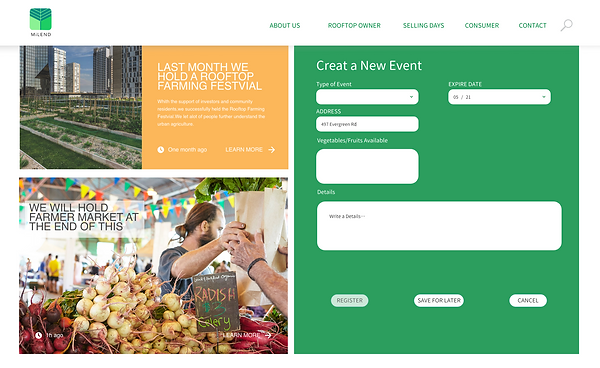
TIMELINE
4 Weeks
MY ROLE
Unifying research findings (on-field & case studies), User Journey, System Design, Interaction Flow Diagrams, Prototyping & UI Interface Design
TEAM
Chia Ling, Mili Rathod, Mert Bozaydin, Yuxiang Sun
MENTOR
Silvio Cioni, Stefania Berselli, Micele Aquila
Background
Resilient Roofs - Platforms and Experiences for urban regeneration. The workshop aimed at designing innovative platforms and experiences to invent novel usages for the roofs of the City of Milan.
We began by first studying Urban cities and the current problems that they face. Our collaboration with the City of Milan allowed us to focus our design problem within the “management, and administration” scope. The problem had to in some capacity impact the citizens and generate interest amongst locals to be actively involved. Both in supporting and adopting these new services and in activities to be carried out on the roofs of the City of Milan.
Research Phase
Secondary Research | Case Studies & Existing Practices
A brief study of various initiatives both in terms of policies and technologies implemented by cities across the world.

100 Resilient Cities
"In order to build a more sustainable and resilient city, the local and national governments need to better link food systems to urban planning agendas and integrate urban agriculture in their climate change agendas."

Urban Innovative Actions (UIA)
-
OpenArgi: New skills for new jobs in peri-urban agriculture
-
An initiative by the European Union to provide resources to test new and unproven solutions to address urban challenges
-
Co-finance 80% of the project activities
-
Share knowledge with other policymakers

Milan Urban Food Policy Pact
-
Development of cities urban food system
-
Sustainable food transportation & logistics
-
Peri-urban activities for shorter food chains
-
Multi-stakeholder platform or food council

Milano Food Policy
-
Food education promoting a culture of consumer-oriented awareness of healthy, safe, culturally appropriate, sustainable food
-
Fight against food waste. Reducing food losses and food waste during the different stages of the food system to limit environmental impact and to contrast social and economic inequalities
-
Energy-efficient municipal public markets
-
Consumption of safe and nutritious food
Sky Vegetables Needham, MA
-
Uses Hydroponic method of farming
-
Hire neighborhood residents to staff the greenhouse and engage their local community
-
Sell the products to the local NYC market
-
SNAP and WIC Certificate

Rotterdam, The Netherlands
-
Local producers are brought in contact with potential local buyers
-
Helps in stimulating new entrepreneurial activities
-
Organizing a Harvest Festival and developing a logistical system for city-region products

Harvest plug-in for Urban Modelling Interface
-
Yield estimation of urban food production and associate energy use
-
Determining economic performance
Urban Greens Blue Grids for Resilient Cities
-
Effectively mobilizing local stakeholders
-
Inform and foster better collaboration
-
Practices for better community engagement
Primary Research | Existing solutions in Milan
Our key insight from our visit was that a lot of these green initiatives and activities already exist waiting to be scaled across. Climate change in totality requires more ways of awareness and a stronger sense of motivation.

ROOFmatters - Presentation with the founders during our visits to dive deeper into the stages of developing, establishing, and expanding a green roof initiative. The team with cultural events, informs and raises awareness of the potential of rooftops amongst both citizens and professionals.
Insights Gained | Our conversations and sharing out initial ideation sessions with the ROOFmatters team helped us realize the potential and expand our scope by not just thinking at the administration level. It also bothered our vision towards different kinds of experiences roofs create.
We conducted three rooftop visits each developed for different purposes and were able to understand the challenges and the benefits realized by each. We conducted semi-structured interviews with the founders and the daily users of these spaces.
Interviews and Field-visits | Existing Green Rooftop Owners
-
Converting their rooftops has been such a rewarding experience
-
It has become a space for our de-brief sessions and some informal meetings and gatherings
-
"Has given a different meaning to our studio and our outlook towards our work"
-
Easier to grow small plants and in different kinds of containers - thus reducing the risk of rooftop cracks in future
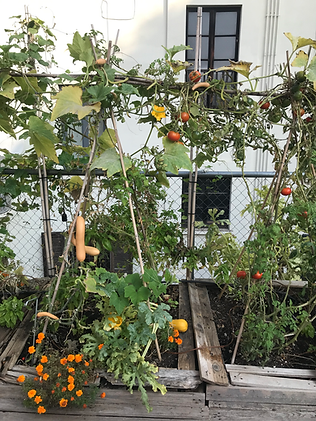
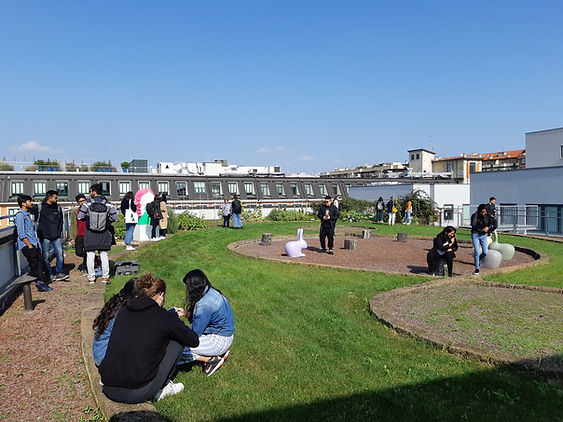
From our visit to Studio Piuarch (Green rooftop of an Architecture studio) and Superstudio Group
Research Findings
The research identified the pain points and challenges involved in setting up green rooftops. Our case studies served us in understanding the factors of success and failures and best practices of such initiatives.
Insights | Factors that can incite Roof Conversions
Food - Promoting healthy food choices, Help transform our food system into a much more sustainable and localized one.
1
Economy - Creating channels for business and income, job opportunities, and support social inclusion activities.
2
Community - Social gathering spaces, transforming the neighborhood, slowly let some of the current farmlands revert back to the natural landscape.
3
Ideation
ROUND ROBIN BRAINSTORMING | HMW SESSIONS
Mapping Opportunity
Next, we participated in a day-long Idea Generation workshop which helped us narrow down and put together the important features that we wanted to focus on. Generating our How Might We statements enabled us to dive deeper and identify challenges for our primary stakeholders. Using our insights in identifying success factors and main elements of what the platform would be.


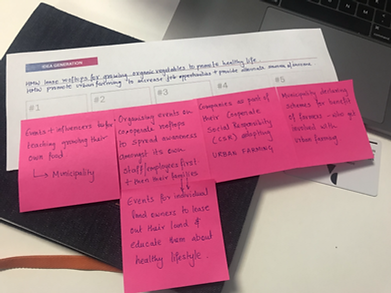
Concept Generation
We each ideated several concepts and then mapped them under the relevant stages of the creation of Green Roofs. Determining unique features and values for our stakeholders. Through a series of design sprints, we developed the initial draft of the concept. Leading us in identifying the roles of our stakeholders and the potential use cases. Below you can see some images from mapping out our concepts.

Concept 1
Pre-defined models from the identified rooftops - percentage share of the output between the roof owners and municipality (utilize for citizens welfare.)
Concept 2
Platform for connecting farmers and roof owners to create an urban rooftop farming business together.
Concept 3
Based on roof typology (commercial, resident) and marking of roofs by 100 resilient cities network modular green roofing setups (rented, salary-based, privately own)
With multiple revisions with our project mentors and valuable feedback from the Chief Resilience Officer for the City of Milan and guidance from the team of ROOFmatetrs we continuously iterated on our concepts to reach the final proposal.


Photos from one of our concept feedback session
Design Response
A platform for connecting farmers, rooftop owners, and the community to create their own green life. The proposed solution aims to serve as a one-point source for all the requirements needed to start an Urban Farming business.
Promoting urban farming in the city
Encourage residents to buy local food
Matching people to build their business
Providing resources, knowledge & inspiration
System Design
STAKEHOLDER MAP
Defining value and their role

MUNICIPALITY
Data collected by mapping of rooftops of Milan as part of the 100 resilient cities efforts was the starting point for pushing the green rooftops initiative forward. Surveying the typology and a general study about the neighbourhood area to spread the word to the citizens.

ROOFTOP OWNERS
Interested rooftop owners (individual or commercial) can register their rooftop with a basic proposal for space. Once the rooftop is completely surveyed and appropriate permissions are acquired both by the residents and the Comune the rooftop owner can look for other partnership and resources through the platform.

FARMERS / WORKERS
Anyone who is interested in contributing either their experience or be a part of an initiative in the neighbourhood area can register for roles and join a system that best suits their needs.
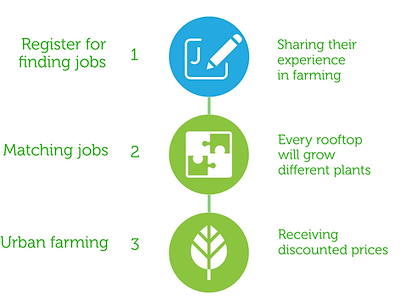
Designing the platform
The clear segregation of roles further helped in determining the Information flow for the complete ecosystem. Also because of the time constraint, we decided to prototype a part of the entire system. After dividing the entire process of roof conversion into different stages for each stakeholder we finalized on prototyping two important processes which we felt were the crucial part in the adoption of these activities and encourage more people to become aware of the rising challenges along with maximizing efforts by the 100 Resilient Cities network and Arup Group.

Consumer-Facing Mobile Application
One of the main objectives with the platform was to serve as a marketing channel for itself to inspire people to utilize the empty spaces available on their rooftops and come together as a community to support the city’s growing demand for resilience. Seeing successful use cases in neighbourhood areas will boost people's confidence and serve as a conversation starter.
Therefore, we focussed on developing the mobile app for the end-users of the entire ecosystem to ease the process of exploring upcoming events (shopping, learning sessions, etc.) in the neighbourhood region, learn more about the practices followed and connect with the urban farmers.
Urban farmers Web Application
The second crucial stakeholder we identified were the rooftop owners right from the stage where they have decided to convert their rooftops. Through our research, we had identified that many people would want to engage and associate themselves with such activities but either lacks the resources or the information. We wanted to ease the process of conversion to encourage more people and minimize the entry barriers. The platform aimed to assist from the first stage of registering the empty rooftop until the last stage where owners can reap the benefits and encourage and educate more people. The platform designed for rooftop owners to provide resources to manage their green rooftop business, events, staff, and yield.
Overview Interactions
After refining our Information Architecture, I designed our interaction flow charts.
Rooftop Owner Overview Interaction

Rooftop Details Overview Interaction

Buyer Overview Interaction

CONSUMER-FACING MOBILE APPLICATION
Prototype
We then started with wireframes and defining our user interface. With the time constraint for the course we decided to focus on prototyping the main features of our system to validate our concepts and present to the committee (ARUP Foundation and City of Milan). We identified the consumer engagement was crucial to our system which in turn will induce more roof conversions and start a conversation amongst the citizens and spread more awareness. Hence, we started focused on the following features
-
see available near-by fresh produce available (quantity, reminder when they are ready to harvest)
-
who is selling / producing what items to understand the requirements better and to build trust and connect with people involved in the project
-
possibility to explore nearby green rooftops and events (sky markets, engagement sessions) organised by their owners
-
register for weekly/monthly subscription boxes of mixed locally produced items and support these small businesses
1
2
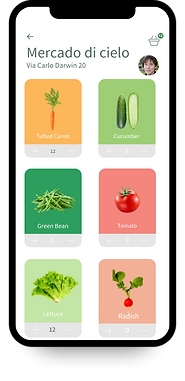

3
4


URBAN FARMERS WEB INTERFACE
Prototype
User interface for the rooftop owners and urban farmers to manage their rooftop business by providing a simple interface that can assist in create events, manage their harvest, rooftop details and tasks with pre-defined templates to reduce the entry and time barriers.



